The important components of nature on earth are plants. They assist us in taking in carbon dioxide and supplying oxygen. This is the benefit of plants. However, plants are helpful in day-to-day existence, from healthy vegetables to beautiful flowers.
Plants go through various processes to stay alive and continue growing.
There are two elements in plants that help in their growth. They are the chloroplast and the chlorophyll.
The difference between chlorophyll and chloroplast is that chlorophyll is the green pigment found in chloroplasts while chloroplast is the important organelle of plants.
Let’s jump to their basic definitions to better understand chloroplast and chlorophyll.
Table of Contents
Definition of Chloroplast
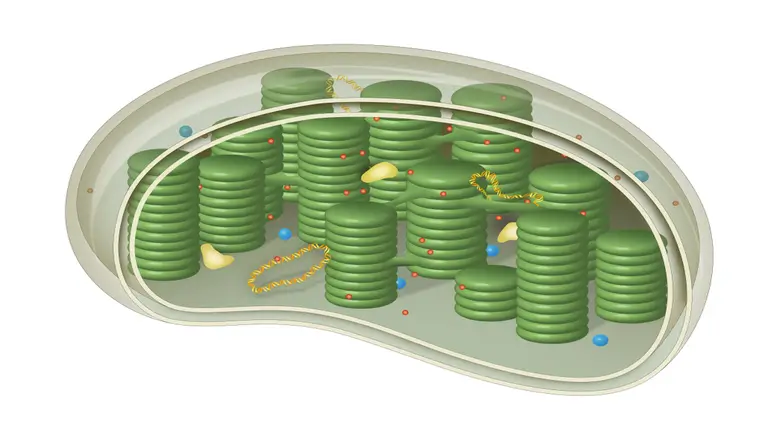
Plant cells include small factories called chloroplasts. They can also be seen in the cells of other photosynthesis-using species.
To create plant food, chloroplasts utilize the energy from sunlight. The food can either be stored as sugar or starch or consumed immediately to provide cells energy.
When the plant needs to perform a function, such as growing a new branch or producing flowers, it can be used if it is kept.
Function of Chloroplasts
- Chloroplasts are responsible for converting carbon dioxide, water, and sunlight into plant food. All species of plants contain chloroplasts, which are organelles that store energy.
- Chloroplasts are found in most plant cells but are most prevalent in the leafy, green regions. Through photosynthesis, the organelles combine sunlight with water and carbon dioxide taken in by other sections of the plant to make food that the plant needs to develop and survive.
- Algae also have chloroplasts, which serve a similar purpose by enabling the algae to survive and grow.
- The chloroplasts also have a variety of yellow and orange pigments that help absorb photon particles from sunlight.
Definition of Chlorophyll
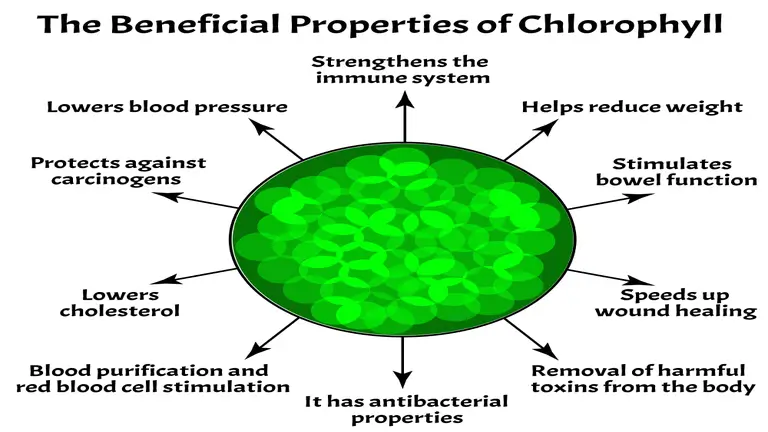
Chlorophyll is the green pigment in plants that gives leaves their green tone.
If leaves are not green, chlorophyll is not present; instead, another pigment, possibly red or yellow in color, may be present.
Function of Chlorophyll:
- Chlorophyll gives plants their characteristic green color and is essential for photosynthesis because it helps convert solar energy into chemical energy.
- Chlorophyll absorbs energy during photosynthesis and converts water and carbon dioxide into oxygen and carbohydrates.
- Green is the only color of the electromagnetic spectrum that chlorophyll does not absorb, which is why it appears green.
Chloroplast Vs Chlorophyll: Structure
Structure of Chloroplast
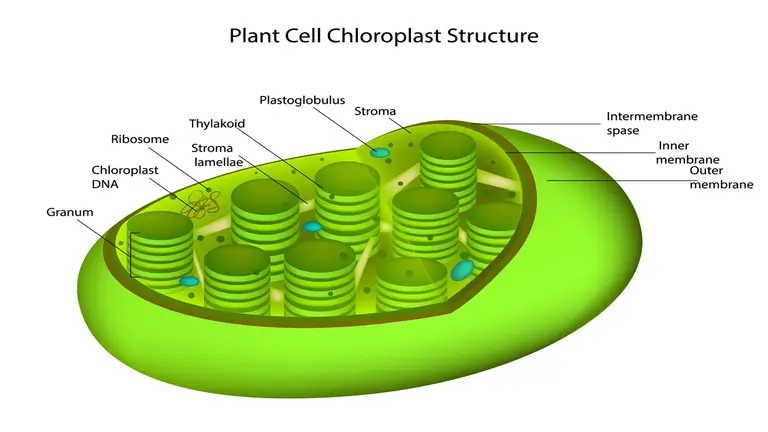
In plants, the number of chloroplasts varies greatly. Chloroplasts are membrane-bound organelles that serve as the primary centers for photosynthesis.
In higher plants, the chloroplasts change from cell to cell but remain constant inside each cell.
Chloroplasts can range in numbers from 30 to 200 per cell, depending on the plant.
Plants that grow in the shade have larger chloroplasts in their cells than those that grow in bright light. Chloroplasts are typically four to five micrometers in size.
Chloroplasts come in various shapes, including plates in Chlorella, cups in the Chlamydomonas and spiral coils in Spirogyra.
The majority of chloroplasts have an oval or roughly spherical shape.
Chloroplast consists of a double membrane, an outer membrane, and an inner.
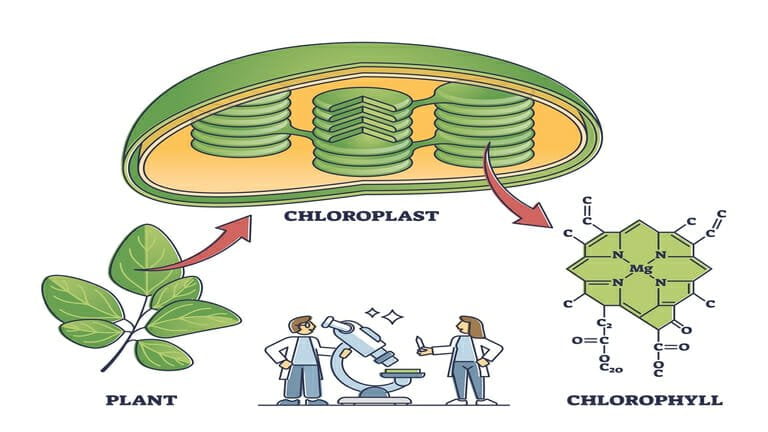
The inner membrane of the chloroplast is selectively permeable and contains numerous transporters, such as integral membrane proteins, which control the flow of small molecules like sugars into and out of the chloroplast.
In contrast, the chloroplast’s outer membrane is freely permeable to molecules.
The chloroplasts perform some autonomous activity since they have their ribosomes and circular DNA.
By binary fission, they divide independently of the cell and can make their proteins from chloroplast DNA and ribosomes.
Structure of Chlorophyll
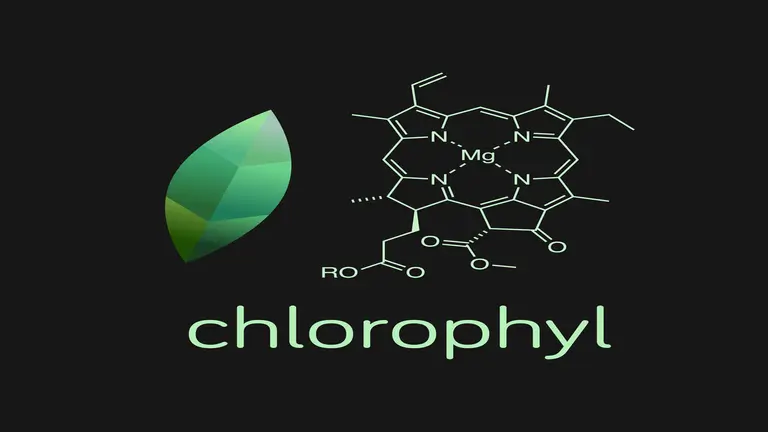
Photosynthesis depends on chlorophyll, a green pigment found in plants, algae, and cyanobacteria.
The structure of aromatic porphyrin or chlorine (reduced porphyrin) ring system with a trapped magnesium atom makes up the bulk of the compound. A fifth ring joins the porphyrin.
The porphyrin ring is a nitrogen-containing structure that surrounds the core magnesium atom in the chlorophyll molecule.
The structure of chlorophyll is very similar to the oxygen-carrying pigment found in the red blood cells of mammals and other vertebrates, hemoglobin.
Difference Between Chlorophyll and Chloroplast
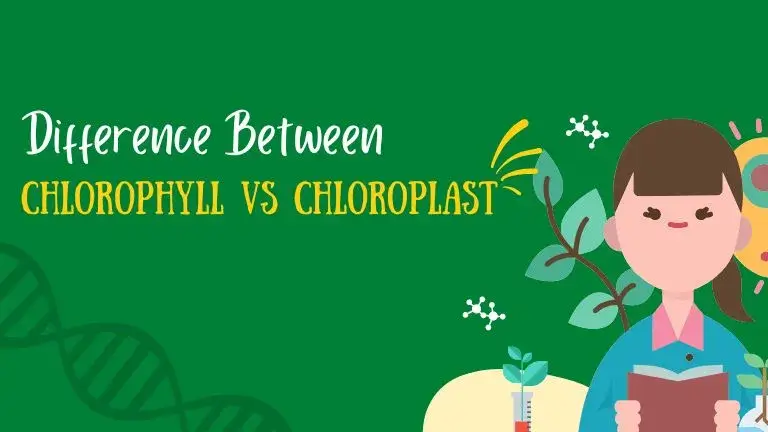
Both eukaryotes and prokaryotes have chlorophyll. But only eukaryotic plants and algae have chloroplasts.
The primary difference between chlorophyll and chloroplast is that the former is a pigment involved in photosynthesis while the latter is an organelle.
- In comparison between chloroplast vs chlorophyll, chlorophyll is that the pigment responsible for photosynthesis is called chlorophyll. While chloroplast is the organelle responsible for photosynthesis.
- Another comparison between chlorophyll vs chloroplast is that chlorophyll absorbs light while delivering highly energetic electrons to photosystems. Chlorophylls are arranged into chloroplasts, which offer room for photosynthesis’s light and dark responses.
- Chlorophylls give chloroplasts their green pigment. Whereas Plants acquire their green color from chloroplasts.
- All plants, algae, and cyanobacteria contain chlorophyll. While only plants and algae chloroplasts.
- Chlorophyll lacks DNA because they are pigments. Chloroplasts are made up of their organelle DNA.
- The thylakoid membrane of chloroplasts contains chlorophyll. Plant leaves are the primary location of chloroplasts.
Comparison Table: Chlorophyll Vs Chloroplast
Highlighting the difference between chlorophyll and chloroplast in the following table:
| Chlorophyll | Chloroplast |
| Plants receive their green color from pigment known as chlorophyll. | Chloroplasts are cellular organelles found in plants and the location of photosynthesis |
| The primary component of chloroplasts is chlorophyll. | The primary component of a plant cell is a chloroplast. |
| All algae, plants, cyanobacteria contain chlorophyll. | All algae and plants contain chloroplast. |
| Chlorophyll contains no DNA. | Chloroplasts have their own DNA. |
| Chlorophylls are of many types but the common types are chlorophyll A and chlorophyll B. | There is no type of chloroplast. |
Conclusion
In plants and algae, photosynthesis depends on chloroplasts and chlorophyll. All photosynthetic species, including prokaryotes and eukaryotes, have chlorophyll.
However, chloroplasts are only present in eukaryotes, such as plants, algae, and plants, as they are membrane-bound organelles.
Cyanobacteria are prokaryotes that only produce chlorophyll and are photosynthetic. The main difference between chlorophyll and chloroplast is that chlorophyll is the green pigment while chloroplast is the organelle.
Read more: What is the Difference Between Force and Pressure?


